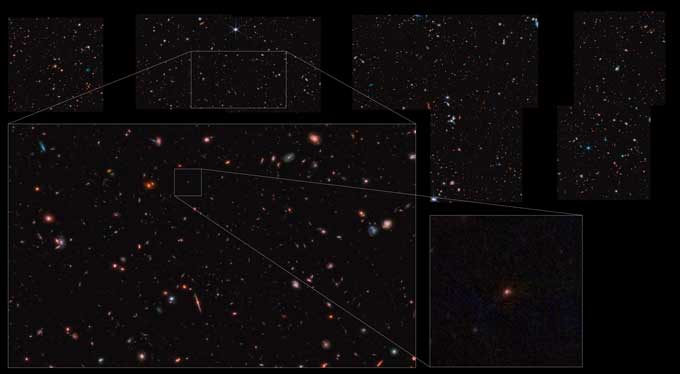This post was originally published on this site
BALTIMORE — The James Webb Space Telescope is living up to its promise as a wayback machine. The spectacularly sensitive observatory is finding and confirming galaxies more distant, and therefore existing earlier in the universe’s history, than any seen before.
The telescope, also known as JWST, has confirmed extreme distances to four galaxies, one of which sets a record for cosmic remoteness by shining about 13.475 billion years ago, astronomers reported December 12 at the First Science Results from JWST conference. Dozens of other galaxies may have been spotted as they were just 550 million years or less after the Big Bang, meaning the light from those galaxies traveled at least 13.1 billion years before reaching the telescope.
Taken together, the new observations suggest galaxies formed earlier and faster than previously thought. “We’re entering a new era,” says astronomer Swara Ravindranath of the Space Telescope Science Institute in Baltimore.
That new era is thanks in part to JWST’s ability to see very faint infrared light (SN: 10/6/21). For the most distant objects, like the first stars and galaxies, their visible light is stretched by the relentless expansion of the universe into longer infrared wavelengths that are invisible to human eyes and some previous space telescopes. But now, measurements that were recently impossible are suddenly easy with JWST, researchers say.
“JWST is the most powerful infrared telescope that has ever been built,” astrophysicist Jane Rigby said at the conference. Rigby, of NASA’s Goddard Space Flight Center in Greenbelt, Md., is the JWST operations project scientist. “Almost across the board, the science performance is better than expected.”
Even in the very first image, released in July, astronomers spotted galaxies whose light originated 13 billion years ago or more (SN: 7/11/22). But those distances were estimates. To measure the distances precisely, astronomers need spectra, measurements of how much light the galaxies emit across many wavelengths. Those measurements are slower and more difficult to make than pictures.
“Thanks to this glorious telescope, we’re now getting spectra … for hundreds of galaxies at once,” said astronomer Emma Curtis-Lake of the University of Hertfordshire in England.
Among those are four of the earliest galaxies ever seen, some of which existed less than 400 million years after the Big Bang, Curtis-Lake and colleagues reported at the meeting and in a paper submitted December 8 to arXiv.org. The team spotted these record holders in a patch of sky that the Hubble Space Telescope once scoured for ultra-remote galaxies (SN: 1/3/10).
The previous distance record holder existed between 13.3 billion and 13.4 billion years ago, or about 400 million years after the Big Bang (SN: 1/28/20). JWST confirmed the distance to that galaxy and came back with three more whose light comes from as early as 325 million years after the Big Bang.
The galaxies are also surprisingly pristine, chemically speaking, lacking in elements heavier than hydrogen and helium.
“We don’t see that in the present-day universe,” says Ravindranath, who was not involved in the new discovery. It could mean that not many of the galaxies’ stars have died in supernova explosions that spread heavy elements around the universe, which suggests the galaxies’ original stars were not extremely massive.
In another part of the sky, JWST has spotted 26 galaxies that may have existed about 550 million years or earlier after the Big Bang, astronomer Steven Finkelstein and colleagues reported at the meeting and in a paper submitted November 10 to arXiv.org.
“On an emotional, visceral level, looking at these images is amazing,” said Finkelstein, of the University of Texas at Austin.
The first of these to be discovered, dubbed Maisie’s Galaxy after Finkelstein’s daughter, appears to be just 380 million years after the Big Bang, the researchers reported December 1 in the Astrophysical Journal Letters. The most distant galaxy in the team’s survey might lie as much as 130 million years earlier than Maisie. Those galaxies’ distances still need to be confirmed with spectra, but the team expect to get those data in the next few weeks.

And distant galaxies that lie behind a massive galaxy cluster called Abell 2744 are also more numerous and distant than expected, astrophysicist Guido Roberts-Borsani of UCLA said at the meeting.
Before JWST observed the cluster, astronomers predicted it should find effectively zero galaxies from 13.2 billion years ago. “But we found two,” said Roberts-Borsani, who reported the results at the meeting. “So something’s a little bit weird.” It could mean that galaxies form earlier and faster than thought, he said, although it could also mean that JWST was just looking at a particularly galaxy-rich patch of the sky.
All these new galaxies are exciting because they could be responsible for making the universe transparent to visible light, a process astronomers call reionization (SN: 12/2/22). Before the first stars ignited, the universe was filled with a hot dense soup of particles. The first stars and galaxies bathed the universe in ultraviolet light, splitting electrons off hydrogen atoms and allowing light to zip through until it reached JWST.
The new data, Roberts-Borsani said, “give us constraints on when this process started, ended, and which galaxies were the culprits for this process.”
